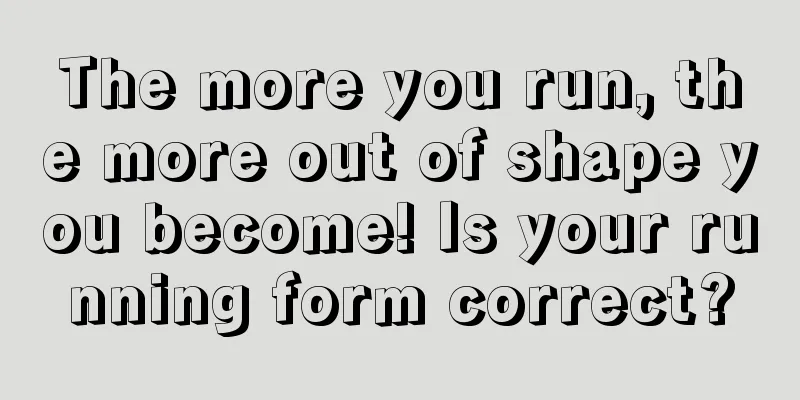The more you run, the more out of shape you become! Is your running form correct?

|
Running is the most common form of exercise for people. As we all know, running can exercise cardiopulmonary function, enhance muscle strength, and continuous and effective jogging can also help burn fat and lose weight. However, if the running posture is incorrect, it will not only fail to achieve the effect of fitness and body shaping, but may also cause harm to physical health and make the body out of shape. Let’s take a look at some incorrect running postures. Common running posture errors 1. Full foot landing When running, if the entire sole of the foot touches the ground, it will be easy to "squat", which can easily cause tibial periostitis. Long-term impact can also easily cause bow legs. 2. Toes on the ground When running, landing with the forefoot will strongly stimulate the calf muscles, which will cause the calves to become thicker over time, forming "carrot legs". 3. Inward and outward splayed feet It can easily cause injuries to the knee joints and other parts of the body, and can also cause X- or O-shaped legs. 4. Leaning forward or backward too much Running forward will cause tension in the back, while running backward will cause excessive tension in the chest and abdominal muscles, which will cause abnormalities in the shoulders, neck and back over time. The correct way to run 1. Stand straight The trunk of the body from the neck to the abdomen should remain naturally upright, without hunching or deliberately straightening, and the amplitude of swaying left and right should not be too large. This posture helps maintain smooth breathing, body balance and coordinated stride. 2. Front and rear swing arms When running, it is very important to swing your arms naturally. The left and right swing of your hands should not exceed the midline of your body, and the up and down swing should not be higher than your chest. During the arm swing, your fingers, wrists and arms should remain relaxed, with your elbows bent about 90 degrees and close to your body. 3. Head and Shoulders Stability While running, your head and shoulders should remain stable and avoid shaking your head. Your eyes should look forward and your shoulders should be relaxed. 4. Gently clench your fist When running, your hands should be clenched naturally and lightly. Clenching your fist too tightly can cause your forearm muscles to tighten, which can hinder normal shoulder movement. When running, do not hold a mobile phone, MP3 or drink bottle in your hands, otherwise it will cause your body to sway and you will not be able to maintain a correct upright posture, increasing the chance of injury. 5. Move forward When running, it is best to avoid sideways movements of the legs. Swinging your legs sideways is not only redundant, but it can also lead to knee injuries. The correct posture should be with your thighs moving straight forward. 6. Short steps If your strides are too big, you will feel like you are stretching your feet forward when running. This will create destructive pressure and can easily cause sports injuries. During daily running, your steps do not need to be too big, and each footstep should be about 33 cm in front of the body. Sudden increase in pace can easily lead to Achilles tendon injury. After landing, your toes should feel a "gripping feeling" and your body should lean forward at the same time to reduce the impact force between your feet and the ground. The less impact force there is, the less risk of injury to the ankle and its joints. 7. Twist your hips slightly During running, the hip twists by about 5 to 7 degrees. Twisting the hips more than 10 degrees can easily lead to problems such as iliotibial band syndrome (lateral knee pain) or hamstring strain. |
<<: Walking protects your heart and fights aging. These benefits you may not expect
>>: Overcome heart problems with one exercise
Recommend
Yoga can reduce your belly, and these four simple moves are must-learn
Yoga has been very popular in recent years becaus...
How to strengthen the human waist bones
A healthy body can enable us to enjoy life better...
What are the most effective exercises for losing weight?
I believe that losing weight is a topic that ever...
Treatment for exercise-induced headaches
Doing some necessary exercise every day is very g...
What are some yoga methods for losing weight quickly?
Today's society is very stressful, and the pr...
How to control the time of fitness effect
Nowadays, health issues can be said to be one of ...
Is Dance Yoga suitable for beginners?
Speaking of yoga, everyone may be familiar with i...
How can I make my calf muscles thinner?
Losing weight is a woman's lifelong mission. ...
Dedicated to you who want to gain muscle, eat it and your muscles will explode immediately
To get the best muscle-building benefits, include...
What to do if you feel chest tightness after strenuous exercise?
Many people will experience various conditions af...
What is the healthiest way to exercise?
Exercise can improve our body's functions to ...
Why is skipping rope ineffective for weight loss?
Rope skipping is a common sport, and nowadays man...
What should you pay attention to when exercising your muscles?
Building muscle is a process that varies from per...
What are some effective hip-lifting exercises?
Having a perfect S-shaped figure is what every fe...
What skills do you need to master in winter long-distance running training?
Different seasons have different temperatures and...









